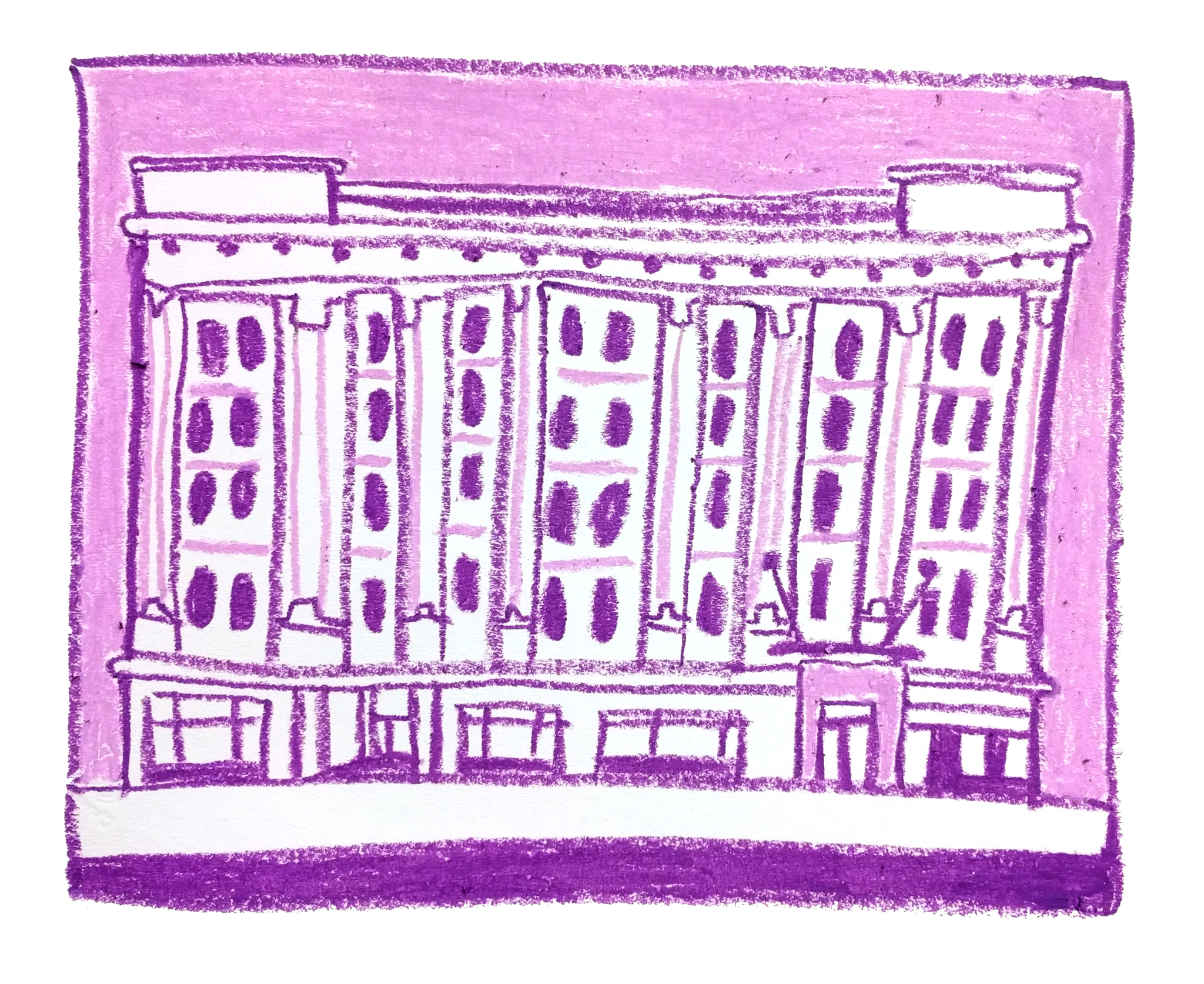Last November, when William and Jacqueline Lynch moved their art gallery into the recently reopened Strand Apartments on 63rd Street and Cottage Grove Avenue, they were unaware of their new building’s historical import. “I did know about the Grand Ballroom down the street,” said William. “I didn’t know anything about this building.”
And it really is easy to walk by the building and see nothing but another red-brick apartment building with a little bit of retail on the ground floor. But in fact, the Strand was built more than a century ago: it stands as one of the oldest buildings in Woodlawn, a neighborhood long marred by demolition and failed promises of urban renewal.
The architecture firm Davis and Davis erected the Strand Hotel between 1914 and 1915. Its Classical Revival style hearkened back to antiquity as a way of lending dignity to the structure. “Designers at the time were looking to Europe to distinguish ourselves as a refined city,” said Bonnie McDonald, President of Landmarks Illinois, a preservation nonprofit. McDonald added that this impulse to build distinguished, lasting buildings was also an attempt to counteract the city’s reputation as a gangster’s haven. “At the time, in Chicago, we had kind of a reputation for gangster activity, so oftentimes we were looking back at architecture we considered to be distinguished or have a lasting permanence,” she said.
In the middle of the twentieth century, the building became famous less for its hotel and architecture, and more for its first-floor jazz club, the McKie’s Disk Jockey Show Lounge, which opened in 1956. In 1964 Jet Magazine described the club as “the only spa on the Windy City’s vast South Side where a patron can go these days and dig first-rate jazz.” Started by longtime WVON DJ McKie Fitzhugh, the club saw performances by musical virtuosos ranging from Sonny Rollins to BB King. It also featured one appearance from John Coltrane that led David Crosby (who may not have been entirely sober) to the point where, in his own words to Mojo magazine, “my mind ran out of my nose in a puddle on the floor.”
The economic decline that hit the South Side during the sixties and seventies took McKie’s with it: the club closed in the late sixties, and Fitzhugh died a few years later, in 1970. The lounge’s legacy lives on, though, in an effort put together by Woodlawn resident Mike Medina to restore the club’s original sign, which had been hanging on the building since McKie’s closed in the late sixties. Medina is currently fundraising on Indiegogo, though he’s raised only a small fraction of the $8,500 he’s asking for.
After McKie’s closed, the building gradually fell into disrepair. Now-indicted 20th Ward alderman Willie Cochran worked there as a police officer in the seventies; he told DNAinfo that the building was then a hub for gang activity. But unlike other historic buildings nearby, such as the Pershing Hotel and Tivoli Theatre, the Strand escaped demolition. In 2014, Holsten Real Estate acquired the property and began a $23 million renovation project with the aim of turning it into affordable housing.
The refurbishment was finished this past fall, with forty-four studio and one-bedroom apartments for low-income residents. It also received Landmark Illinois’s Project of the Year award. “We recognize the building is a beacon for the neighborhood. There is an interested marketplace for creating vibrant housing and retail for other vacant property,” said McDonald. “The history of this property only contributes to the importance of it in the neighborhood.”
Apart from apartments, the building also contains a Subway, a Metro PCS, and the Lynches art gallery, Ariel Joseph Art Gallery and Salon. They originally owned a smaller, more anonymous location on 64th Street, and moved into the Strand because of its possibility for more foot traffic.
The Strand’s resurgence comes just as renewed attention is being paid to Woodlawn from municipal and private developers. Not only did Woodlawn win Curbed Chicago’s 2016 Neighborhood Cup competition, but the website also reported that the neighborhood is one of the real estate website Redfin’s two “hottest neighborhoods” for 2017, based on recent growth. Curbed Chicago named Woodlawn its hottest neighborhood for 2017; while it’s unclear how much new development will end up benefiting Woodlawn’s current residents, the selection of Jackson Park as the Obama Library site means change is inevitable, and a number of community groups are trying to get out in front of it. For their part, the Lynches are happy to see the change. “There’s all the development that’s going on, with the squash court and the elementary school around the corner, and then we found out the presidential library was going to be right down the street,” said William Lynch. “It was like, ‘Wow, we can’t ask for a better place for the future.’”
Did you like this article? Support local journalism by donating to South Side Weekly today.


I found your article on the Strand Hotel, and Mike Medina’s efforts to revive the McKie’s sign of interest. As a young man I saw several acts at McKie’s, including Coltrane’s band and the Jazz Crusaders. I think Mr. Medina’s project is worth donating to, but it seems that both of his Indiegogo fundraising accounts are closed, and I haven’t been able to find any other ways of contacting him. Please send my contact info on to him.
Thanks, Aaron Fagen
This building looks nice on the outside. Why dont you interview ppl that live in the building who can tell you all the things thats not right in the building and outside the building